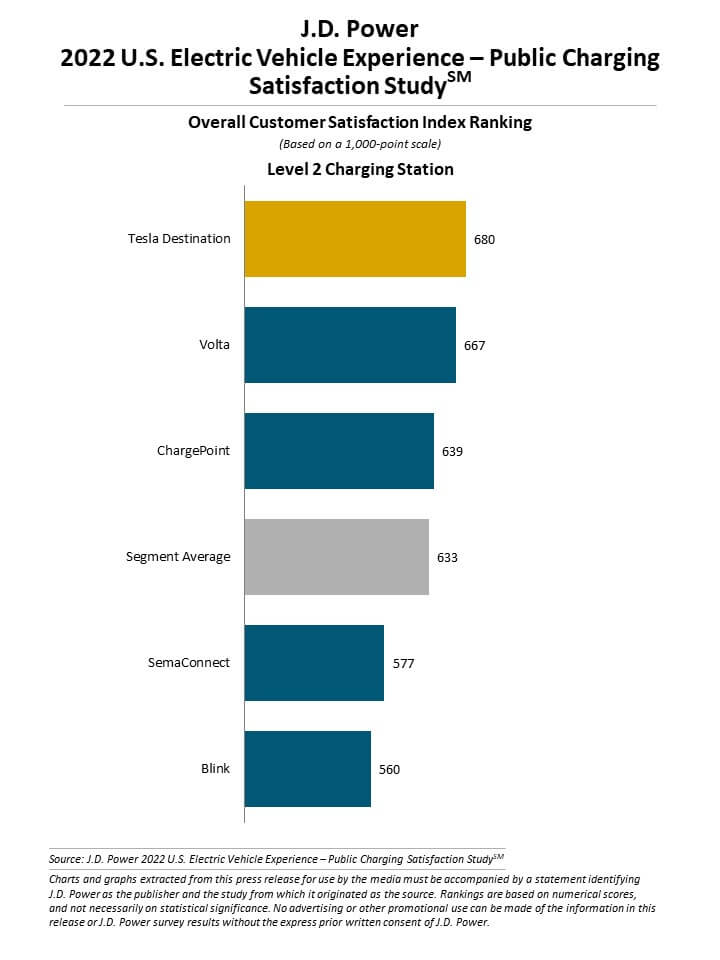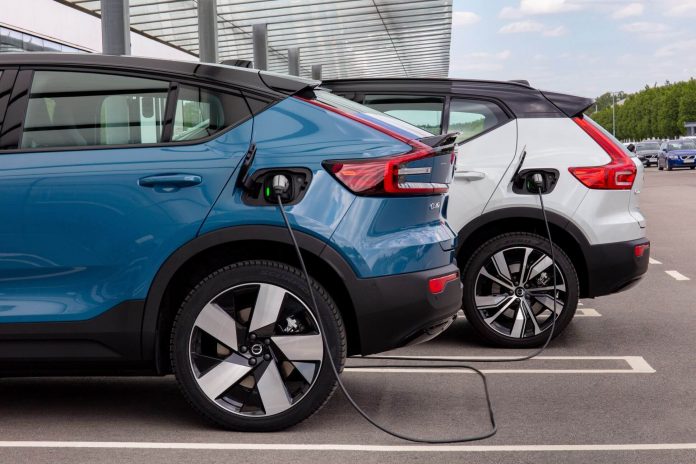The growth of electric vehicle (EV) sales during the past year has been remarkable but has added stress to an already beleaguered public vehicle charging infrastructure. In this growth spurt, owners in high EV volume markets like California, Texas and Washington, for instance, are finding the charging infrastructure inadequate and plagued with non-functioning stations. These are among the key findings in the second annual J.D. Power U.S. Electric Vehicle Experience (EVX) Public Charging Study, released today.
Despite that more public charging stations are in operation than ever before, customer satisfaction with public Level 2 charging declined from last year, dropping to 633 (on a 1,000-point scale) from 643 in 2021, while satisfaction with the speedier DC (direct current) fast charger segment remains flat at 674. This lack of progress points to the need for improvement as EVs gain wider consumer acceptance because the shortage of public charging availability is the number one reason vehicle shoppers reject EVs. Tesla Destination ranks highest among Level 2 charge point operators with a score of 680 and Tesla Supercharger ranks highest among DC fast chargers with a score of 739.

“Public charging continues to provide challenges to overall EV adoption and current EV owners alike,” said Brent Gruber, executive director of global automotive at J.D. Power. “Not only is the availability of public charging still an obstacle, but EV owners continue to be faced with charging station equipment that is inoperable. The National Electric Vehicle Infrastructure (NEVI) Formula Program promises to provide funds to states for building out their EV public charging infrastructure. This will lead to sizable growth in the availability of EV charging stations, but just adding stations isn’t the answer. Stations need to be added to areas where there are currently gaps in heavily traveled routes and in high-density areas for people who don’t have access to residential charging, but most importantly, designed with things for users to do while charging—regardless of the use case. Then, we need to make sure those stations are reliable.”
The study measures EV owners’ satisfaction with two types of public charge point operators: Level 2 charging stations and DC fast charger stations. Satisfaction is measured across 10 factors: ease of charging; speed of charging; cost of charging; ease of payment; ease of finding this location; convenience of this location; things to do while charging; how safe you feel at this location; availability of chargers; and physical condition of the charging location.
Following are key findings of the 2022 study:
- Most owners relatively satisfied with ease of charging process: Satisfaction with the ease of charging at a DC fast charger is 745 among battery electric vehicle (BEV) and plug-in hybrid electric vehicle (PHEV) owners, and satisfaction with the ease of charging at a Level 2 charging station is 699. This indicates that current EV owners understand the operation of both types of chargers, so the systems themselves do not prompt issues. But virtually all other attributes related to public charging score lower. Some, like cost of charging, are much lower: 473 for DC fast chargers and 446 for Level 2 chargers.
- Public charger operability and maintenance a key issue: Growth of the public charging infrastructure is making it easier for EV owners to find public charging stations. The index for ease of finding a location is 724 among users of DC fast chargers and 683 among users of Level 2 chargers. But the industry needs to do a better job of maintaining existing charging stations. The study finds that one out of every five respondents ended up not charging their vehicle during their visit. Of those who didn’t charge, 72% indicated that it was due to the station malfunctioning or being out of service.
- Owner satisfaction with availability of public charging stations differs by region: Led by California, the Pacific region has the highest number of public chargers. At the same time, it has the highest concentration of EV owners, yet they are not as satisfied with the availability and condition of public chargers as EV owners in some other geographic areas. The West North Central region (Iowa, Kansas, Minnesota, Missouri, Nebraska, North Dakota and South Dakota) has the highest level of satisfaction with the availability of public charging. The East North Central region (Illinois, Indiana, Michigan, Ohio and Wisconsin) has the highest level of satisfaction with the condition of public chargers.
- DC fast charger users are planners: Users of Level 2 chargers cite convenience and price as the two key reasons for choosing a charging location. Users of DC fast chargers, on the other hand, are often on a planned road trip which, along with convenience, determines their choice of charging location. Often, they have few logical alternatives.
“Everyone knows that the landscape of gas stations is focused on convenience—readily available, fast fueling and quick convenience items,” Gruber said. “Although fast charging is seemingly getting faster by the day, to expedite the charging process vehicles will need to accommodate the newest ultra-fast chargers. Currently, only a handful of vehicles can take advantage of the fastest charging speeds. And no matter how fast their vehicle charges, EV owners still indicate they need more options for things to do during each charging session to enhance convenience and fill the down time.”
Study Rankings
Tesla Destination ranks highest among Level 2 charging stations with a score of 680. Volta (667) ranks second and ChargePoint (639) ranks third.
Tesla Supercharger ranks highest among DC fast chargers with a score of 739. It is the only DC fast charger brand to rank above industry average.
The 2022 U.S. Electric Vehicle Experience (EVX) Public Charging Study is driven by a collaboration with PlugShare, the leading EV driver app maker and research firm. The study examines consumer attitudes, behaviors and satisfaction, setting the standard for benchmarking the overall experience of public EV charging. Respondents included 11,554 owners of battery electric vehicles (BEVs) and plug-in hybrid electric vehicles (PHEVs). The study was fielded from January through June 2022. Drivers who visited the charging location but didn’t charge their vehicle were asked why they decided not to charge.

